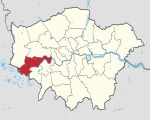Municipal Borough of Heston and Isleworth
Districts abolished by the London Government Act 1963Districts of England created by the Local Government Act 1894History of local government in MiddlesexHistory of the London Borough of HounslowIsleworth ... and 1 more
Municipal boroughs of England

Heston and Isleworth was a local government district of Middlesex, England from 1894 to 1965.
Excerpt from the Wikipedia article Municipal Borough of Heston and Isleworth (License: CC BY-SA 3.0, Authors, Images).Municipal Borough of Heston and Isleworth
Glenetalstraße,
Geographical coordinates (GPS) Address Website Nearby Places Show on map
Geographical coordinates (GPS)
| Latitude | Longitude |
|---|---|
| N 51.47 ° | E -0.35 ° |
Address
Lippoldshöhle
Glenetalstraße
31061
Niedersachsen, Deutschland
Open on Google Maps




